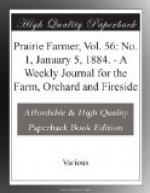ingredients) it is, in the common vernacular of the
gardener, too rank to give good growth and results,
whether it be in fruits, flowers, or foliage.
For example, in Henderson’s horticulture he recommends,
as the best soil for potting, loam and hops.
He says, “Not the least simple of these operations
is the preparation of our potting soil. We have,
we may say, only one heap—a big one it
is—but it contains only two ingredients,
rotted sods, from a loamy pasture, and rotted refuse
hops from the breweries, in about the proportion of
two of the sods to one of hop. One-year-old rotted
manure, if the hops cannot be obtained.”
It is evident upon its face that so large a proportion
as one-third of a fresh manure or hops would be disastrous;
but well rotted, and with care otherwise in temperature
and other desiderata, it would be a highly stimulating
soil. This was in 1869. We well recollect
the commotion the hop business caused in the horticultural
world at the time, as Henderson recommended it for
plunging pots in, setting pots on mulching outdoors,
and almost every purpose. And did he not grow
the best of stuff and himself practice what he preached.
Spent hops in this city were eagerly sought after
and used, apparently with great success, in almost
every florist’s establishment as well as market
garden. What before was a nuisance to the breweries
was eagerly sought after; like most things, however,
it had its day, and is now seldom seen again.
We might, however, say that its decline undoubtedly
arose from its unpleasant features, as it drew myriads
of insects in its train and often emitted a very unpleasant
odor. Its great value consists in that it is the
seed of the hop plant, all seeds contributing by far
the greatest value in manures.
In the green-house the object aimed at, is the greatest
possible results from limited area. Of the atmosphere
the gardener has almost absolute control—no
siroccos, biting frost, or destructive winds interfere.
He can beat nature all to pieces in growing plants
faultless in shape and in quantity of flowers, but
his soil is of limited extent for the roots to wander
in. To counteract this, he can give in other forms
just as much and no more nutrition as is necessary
to effect his purpose, and here comes in this artificial
supply of manurial agents.
Mr. DeVrey, the successful superintendent of Lincoln
Park, uses horn shavings. This is the cleanest
and most pleasant material that we ever recollect
to have seen used for the purpose, it is the refuse
in the factories where the horns from the slaughterhouse
are steamed and manipulated into the numerous objects
they are applied to, not the least being into knife
and fork handles, and the like. It is in the form
of thin shaving of half an inch to an inch in length,
quite dry and light, entirely free from odor.
He takes all they make, and this year has a ton of
the material for which he pays at the rate of three
cents per pound. The method of using is simply




